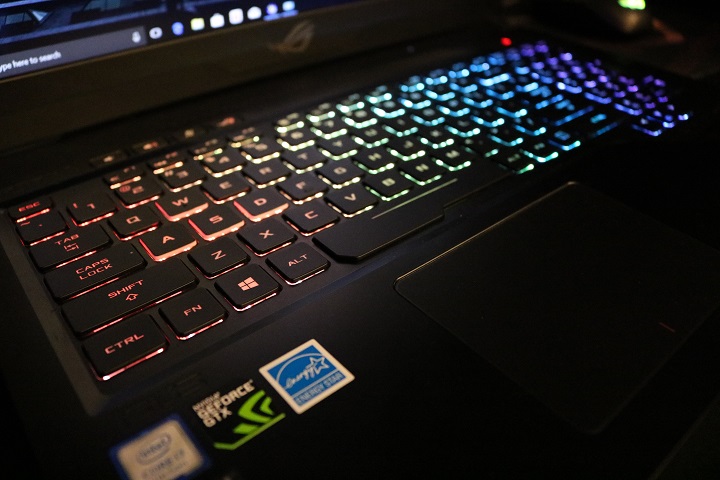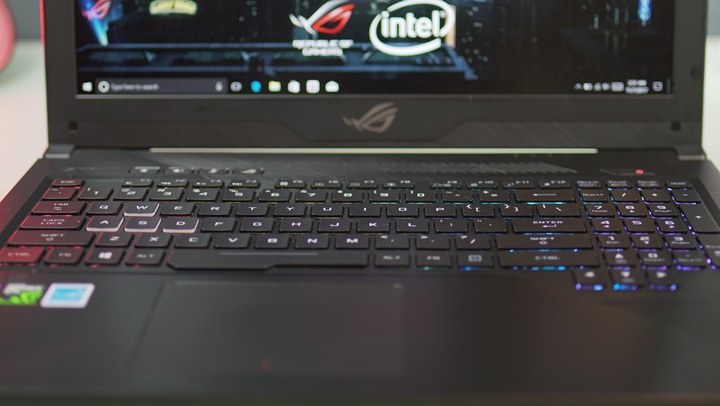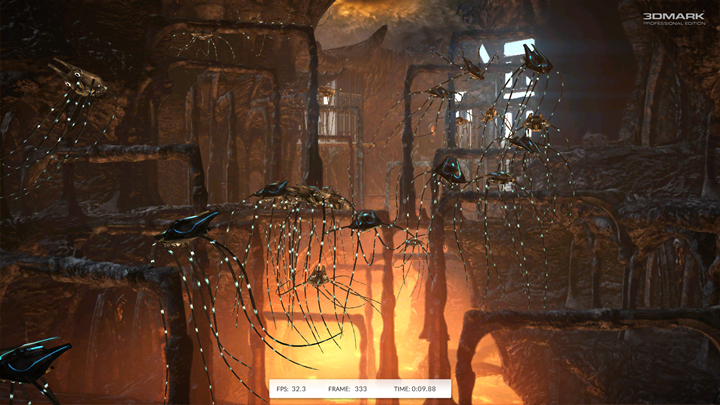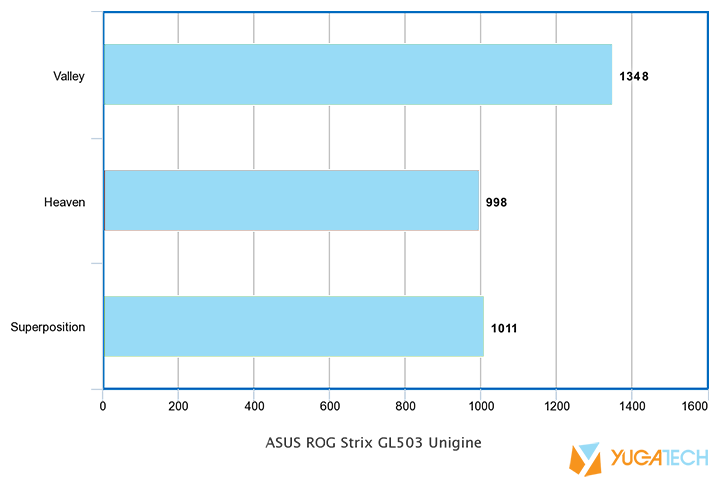ASUS is well-known for the laptops they have under their Republic of Gamers brand. They are often high-specced and obviously marketed towards PC gamers. Today we’ll be taking a look at the ASUS ROG Strix GL503, one of their latest 15.6-inch gaming notebooks that packs the hardware necessary for playing heavy games at high settings.

The particular variant we’ll be taking for a spin has an Intel Core i7-7700HQ, GTX 1050, 8GB of DDR4 memory, and an SSD. In our first impressions article, we referred to this setup as fairly standard, but it hits the sweet spot for a 15.6-inch gaming laptop.
Table of Contents
Up front, the GL503 looks about like what you’d expect from an ASUS ROG laptop. It’s laid-back but still takes some inspiration from other more aggressive ROG products. The ROG logos can be found plastered around the laptop, and the font used on the keys is definitely gamer-centric.

The 15.6-inch screen is surrounded by fairly thick bezels by today’s standards, but we haven’t really seen those disappear much from gaming laptops, and they probably don’t really need to.

In our first impressions article, we thought that both the lighting and non-traditional layout on the keyboard wasn’t too great, but we have since made a few discoveries about these two things – The backlight actually looks very bright when you’re actually sitting down in front of the unit, and the keyboard layout isn’t too bad even on your first try.
The keys themselves have a good size, and the amount of travel is actually quite good for gaming.

The trackpad’s surface still doesn’t feel too great. Your fingers don’t easily glide across its surface. The click also goes way too deep and doesn’t really feel springy.

Looking at the lid, it has a really nice faux brushed aluminum finish with a unique implementation of the ROG logo. It appears silver when the unit is powered off, but it actually illuminates red when on.
The GL503 boasts a design that somehow manages to both appeals to gamers, as well as be stealthy in that regard. It’s naturally hefty given its 15.6-inch form factor, but it doesn’t feel all that strongly built since it’s made of mostly plastic.
If you’re going to use a laptop like this, odds are, your purpose is gaming. That said, despite the shortcomings of the trackpad, the included mouse is very nice. It has side buttons, on-the-fly DPI adjustment, RGB lighting, a smooth matte finish, and a comfortable grip.

As for power, the GL503’s power brick is pretty beefy but not as massive as some others we’ve seen in the past such as the one the GX800 uses.

The 15.6-inch IPS display has a resolution of 1920 x 1080 at 60Hz. Brightness is very good as it can even be used near an open window in the daytime. Contrast, sharpness, and color reproduction are also decent. It’s not the high refresh rate display you’d want on a gaming machine, but the fact that it’s an IPS panel means that you’re not limited by the quality shortcomings of a TN panel.

The speakers were impressively loud, and are able to cancel out the very loud fan noise the unit generates, which we will discuss later. At maximum volume, it’s muffled, but a little adjustment reveals good clarity and noticeable bass.
Both the display and audio can be tuned with the included ASUS Splendid and Sonic Studio 3 apps, respectively.
Naturally, the laptop runs on Windows 10 Home Edition. There are quite a few pre-installed apps here including some proprietary ASUS apps, Microsoft Office 2016, some games like Minecraft and March of Empires, and unfortunately, both Avast and McAfee antivirus.

Above the keyboard is a dedicated button with a ROG logo that when pressed, launches the ROG Gaming Center app, which is a very nice rendition of a control center-style interface. You can use it to monitor device stats, as well as access a few gaming-oriented features like ROG Game First and the ability to disable the Windows key.
As for storage, we have a combination of a 128GB SATA SSD and 1TB SATA HDD, which makes for a great combination of both speed and capacity. This is a great setup that is fairly standard these days. The OS and high priority software can stay in the SSD, while your game library and other large files can be stored in the 1TB drive.
Under the hood, this variant of the GL503 sports an Intel Core i7-7700HQ CPU, GTX 1050 GPU, and 8GB of DDR4 memory @ 2400MHz. In our initial testing, it struggled at running demanding AAA games at maximum settings.

Keeping our standard at 60fps for optimal average frame rates, the laptop performed great at medium to high settings on six games we used for benchmarking. Check out the results below.
Note: Scores are in average frames per second.

We tested performance further using 3DMark as well as the Unigine suite of benchmarks.


As for physical I/O, we’re treated to a very good mix of ports but still sort of lacking. The left side houses the DC-in, RJ45 LAN, mini Display Port, HDMI, a couple of USB 3.0 Type-A ports, and a combo audio jack. The right side keeps a full-size SD card slot, USB 3.1 Gen.1 Type-C, USB 3.0, USB 2.0, and a Kensington lock.

It’s definitely enough to get you going, but ASUS missed a couple of marks here. The USB 2.0 port really should be located on the other side for a more optimal location for plugging in a mouse. Also, this one is a long-shot, but it would have been really nice to see Thunderbolt 3.

Wireless connectivity options are Wi-Fi 802.11ac and Bluetooth 4.1. Both works as advertised, and online gaming using Wi-Fi was not problematic. Ethernet is obviously the way to go for that aspect, but with a good connection, you shouldn’t notice a huge difference.
We subjected the GL503 to our standard video loop test (1080p MP4 file played on loop, airplane mode, 50% brightness and volume), and it lasted 2 hours and 15 minutes. This is expected, given that the battery isn’t exceptionally big, while the laptop packs some heavy hitting hardware.
We subjected the i7-7700HQ and GTX 1050 to the Prime 95 and FurMark stress tests, respectively. The GTX 1050’s temperature hit its ceiling at 64°C, while the i7-7700HQ didn’t do so great, maxing out at 83°C.

The GTX 1050 is a lower-tier GPU which is built on NVIDIA’s highly efficient Pascal microarchitecture, which explains why it managed to stay fairly cool by comparison. With the 7700HQ on the other hand, the story wasn’t as good. The culprit here could possibly be the cooling system. When the system is under load, the fans get so loud that it can be distracting during gameplay, even when wearing headphones. The exhaust grilles and some parts of the keyboard also get way too hot to even touch.
The ASUS ROG Strix GL503 is a sleek, gamer-centric laptop that will suit the needs of most. As of the present, it’s capable of getting respectable frame rates in graphically demanding AAA games, at medium to high settings. A few years down the line though? Your investment may start to struggle given the fact that game requirements increase every year, and this laptop only packs a GTX 1050.

Aside from performing decently, we did mention at the start of this review that the hardware configuration this GL503 packs is fairly standard for a 15.6-inch gaming notebook. However, we think it’s not a good enough value, given that it costs about Php70k. At that price point, you should already be able to find a gaming laptop that packs a GTX 1060.
ASUS GL503 specs:
15.6-inch FHD IPS display
2.8GHz Intel Core-i7 7700HQ CPU
NVIDIA GTX 1050 GPU w/ 4GB VRAM
8GB DDR4 2400MHz RAM
1TB SATA HDD
128GB SATA3 SSD
Wi-Fi 802.11 AC
Bluetooth 4.1
3x USB 3.0
1x USB 3.1 Gen.1 Type-C
1x USB 2.0
1x HDMI
1x mini-Display port
1x RJ45 LAN jack
1x combo audio jack
Multi-format card reader
ASUS SonicMaster Technology
4 Cells 64Wh Battery
Windows 10 Home
383.54 x 261.6 x 22.9mm
2.54kg
This particular variant of the ASUS ROG Strix GL503 (i7-7700HQ + GTX 1050) is priced at Php69,995USD 1,193INR 101,115EUR 1,136CNY 8,686.
What we liked:
What we didn’t:

YugaTech.com is the largest and longest-running technology site in the Philippines. Originally established in October 2002, the site was transformed into a full-fledged technology platform in 2005.
How to transfer, withdraw money from PayPal to GCash
Prices of Starlink satellite in the Philippines
Install Google GBox to Huawei smartphones
Pag-IBIG MP2 online application
How to check PhilHealth contributions online
How to find your SIM card serial number
Globe, PLDT, Converge, Sky: Unli fiber internet plans compared
10 biggest games in the Google Play Store
LTO periodic medical exam for 10-year licenses
Netflix codes to unlock hidden TV shows, movies
Apple, Asus, Cherry Mobile, Huawei, LG, Nokia, Oppo, Samsung, Sony, Vivo, Xiaomi, Lenovo, Infinix Mobile, Pocophone, Honor, iPhone, OnePlus, Tecno, Realme, HTC, Gionee, Kata, IQ00, Redmi, Razer, CloudFone, Motorola, Panasonic, TCL, Wiko
Best Android smartphones between PHP 20,000 - 25,000
Smartphones under PHP 10,000 in the Philippines
Smartphones under PHP 12K Philippines
Best smartphones for kids under PHP 7,000
Smartphones under PHP 15,000 in the Philippines
Best Android smartphones between PHP 15,000 - 20,000
Smartphones under PHP 20,000 in the Philippines
Most affordable 5G phones in the Philippines under PHP 20K
5G smartphones in the Philippines under PHP 16K
Smartphone pricelist Philippines 2024
Smartphone pricelist Philippines 2023
Smartphone pricelist Philippines 2022
Smartphone pricelist Philippines 2021
Smartphone pricelist Philippines 2020